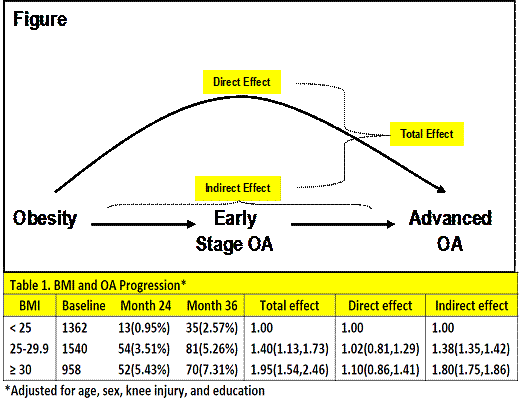Session Information
Session Type: Combined Abstract Sessions
Background/Purpose: While obesity is a well-established risk factor for incident knee osteoarthritis (OA), it has a null association with OA progression. Among various potential explanations for such a paradox, one is a lack of precision in the research question. While investigators are interested in the total effect of BMI on OA progression among OA patients, most studies have instead measured a direct effect of BMI in the general population (Figure). This is because in these studies, data on BMI were assessed prior to OA diagnosis, or BMI measured after OA diagnosis has remained mostly unchanged compared with that prior to OA incidence. We have demonstrated this potential mechanism underlying the paradoxical findings of BMI in OA progression by decomposing its effect components (Figure) using mediation analyses.
Methods: Knee radiographs were taken at baseline and each annual follow-up visit, and severity of knee radiographic OA was assessed using Kellgren/Lawrence (KL) criteria among participants in the Osteoarthritis Initiative. We identified subjects who had no OA on either knee at baseline (i.e., KL <2) and used KL scores measured at 24-month and 36-month visits to assess radiographic OA progression. Baseline BMI was categorized as: <25, 25 –29.9 (i.e., overweight), and ≥30 kg/m2 (i.e., obese). We first assessed the total effect of BMI on KL grade worsening at Month 36 (Figure). We then decomposed the effect into the indirect effect of BMI (i.e., the pathway through its effect on KL grade at Month 24) and the direct effect (i.e., the pathway not through its effect on KL grade at Month 24) (Figure), using marginal structural model mediation analyses. All analyses were adjusted for age, sex, knee injury, and education.
Results: Of 1930 subjects without knee OA on either knee (56% women, mean age 59 years) at baseline, 186 knees developed OA (e.g., 144 with KL=2, 41 with KL=3, and 1 with total knee replacement therapy) over 36 months. Compared with those with BMI <25, overweight and obese subjects had a 1.40 (95% CI: 1.13-1.73) and 1.95-fold (1.54-2.46) increased risk of KL grade worsening, respectively, after adjusting for potential confounders. Conditioning on the KL grade at Month 24, the indirect effects of being overweight and obese on OA progression were 1.38 (95% CI: 1.35-1.42) and 1.80 (1.75-1.86), respectively; however, the corresponding direct effects were 1.02 (0.81-1.29) and 1.10 (0.86-1.41), indicating that the effect of BMI on OA progression at Month 36 is entirely through its effect on OA progression at Month 24.
Conclusion: Our findings demonstrate that the paradoxical findings of BMI on the risk of OA incidence and OA progression are due to a mismatch between an intended total effect of BMI on OA and its direct effect in the general population. To obtain the intended total effect of BMI on OA progression, one could use the change in BMI after OA diagnosis as an exposure for the outcome of OA progression.
Disclosure:
Q. Louie-Gao,
None;
H. K. Choi,
None;
D. T. Felson,
None;
T. Neogi,
None;
U. S. D. T. Nguyen,
None;
N. Lu,
None;
Y. Zhang,
None.
« Back to 2014 ACR/ARHP Annual Meeting
ACR Meeting Abstracts - https://acrabstracts.org/abstract/obesity-paradox-in-osteoarthritis-progression-what-effects-are-we-measuring/

